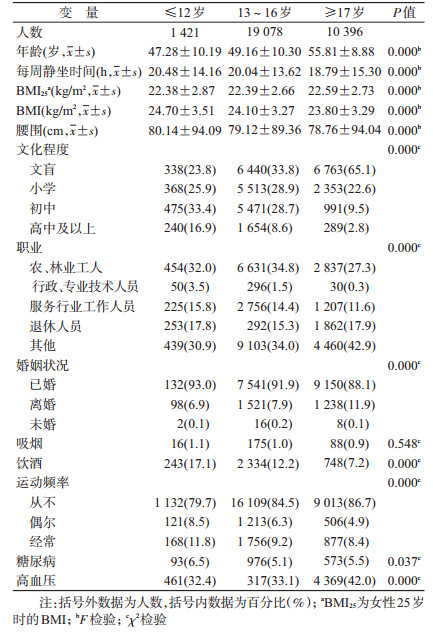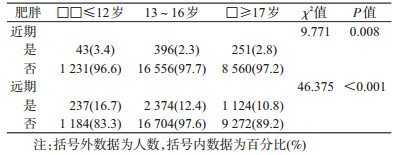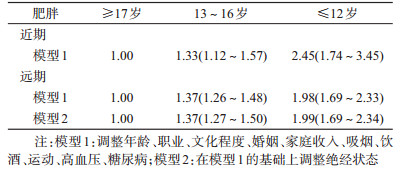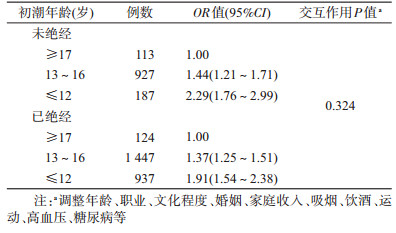文章信息
- 韦晓淋, 华钰洁, 陆艳, 胡一河, 卞铮, 郭彧, 陈铮鸣, 李立明.
- Wei Xiaolin, Hua Yujie, Lu Yan, Hu Yihe, Bian Zheng, Guo Yu, Chen Zhengming, Li Liming.
- 月经初潮年龄对女性成年后近期和远期肥胖的影响
- Impact of menarche age on the near-term and long-term obesity of adult females
- 中华流行病学杂志, 2019, 40(2): 142-146
- Chinese Journal of Epidemiology, 2019, 40(2): 142-146
- http://dx.doi.org/10.3760/cma.j.issn.0254-6450.2019.02.004
-
文章历史
收稿日期: 2018-08-27
2. 中国医学科学院慢性病前瞻性研究项目办公室, 北京 100730;
3. 英国牛津大学临床与流行病学研究中心 OX3 7LF;
4. 北京大学公共卫生学院 100191
2. Project Office of the China Kadoorie Biobank, Chinese Academy of Medical Sciences, Beijing 100730, China;
3. Clinical Trial Service Unit and Epidemiological Studies Unit, University of Oxford, Oxford OX3 7LF, United Kingdom;
4. School of Public Health, Peking University, Beijng 100191, China
月经初潮是女性在生长发育过程中的重要成熟标志、也是女性未来生活中许多慢性疾病的重要预测因素。近年来女性月经初潮年龄有提前的趋势[1]。与此同时,女性成年后慢性病发病率也出现不同程度的增加。月经初潮年龄过早是高血压[2]、糖尿病[3]、心血管疾病[4]、MS[5]及青春期肥胖[6]的重要危险因素。本研究利用中国慢性病前瞻性研究(China Kadoorie Biobank,CKB)中苏州点的基线调查数据,采用病例对照研究的方法,探讨女性月经初潮年龄与成年后近、远期肥胖的关系。
对象与方法1.研究对象:来自于CKB项目苏州点所有具有完整初潮与身体测量数据信息的30 895名≥35岁女性,苏州点的基线调查从2004年8月至2008年5月。在调查开始前,本研究获得了中国CDC伦理审查委员会和英国牛津大学热带研究伦理委员会的批准。CKB调查对象的入选标准和排除标准以及有关项目其他情况见文献[7-9]。
2.调查方法:①问卷调查:由经过培训合格的调查员按照统一的问卷调查方法和标准,采取面对面方式进行年龄、性别、职业、吸烟、饮酒、饮茶情况、身体活动、体力活动、疾病及健康状况、初潮年龄、头胎生育年龄、有无绝经等调查。②体格检查:包括身高、体重、血压等。身高采用身高仪测量,测量时脱去鞋袜,测量值精确到0.1 cm;体重采用TANITATBF-300GS体质构成分析仪测量,读数精确到0.1 kg;BMI=体重/身高2(kg/m2)。
3.变量:①初潮:初潮年龄通过回顾性询问调查对象“你第一次来月经时的实足年龄是多大?”获得。查阅相关文献[10]并根据本研究对象的四分位月经初潮年龄,将初潮年龄分为“≤12、13~16、≥17岁”3组,其中≤12岁定义为初潮年龄过早。②肥胖:以BMI≥28 kg/m2作为评价肥胖的指标。青壮年时期肥胖定义为近期肥胖:以女性25岁时的身高与体重计算BMI25获得;中老年时期肥胖定义为远期肥胖:以女性填写问卷时的身高与体重计算BMI获得,而本研究对象绝大多数在填写问卷时年龄为45~60(51.31±10.36)岁,处于中老年时期。
4.统计学分析:使用SPSS 19.0软件进行统计学分析,计量资料采用x±s的形式表示;计数资料使用频数(%)表示,3组间均数的比较用方差分析,3组之间率的差异比较用χ2检验。使用单因素和多因素logistic回归分析女性初潮年龄与成年后近、远期肥胖的关系。在多重logistic回归模型的基础上,纳入交互项,分析初潮年龄与绝经状态对远期肥胖的交互作用。以P<0.05为差异有统计学意义。
结果1.一般情况:共纳入具有完整月经史及身体测量数据信息的30 895名女性,年龄为(51.31±10.36)岁。月经初潮年龄为(15.64±1.92)岁,月经初潮过早1 421人(4.6%)。调查对象每周静坐时间为(19.64±14.24)h,腰围为(79.05±9.12)cm,BMI为(24.06±3.30)kg/m2。调查对象25岁时的BMI为(22.45±2.69)kg/m2。不同初潮年龄调查对象的基本特征及3组比较见表 1。
2.不同月经初潮年龄组成年女性近、远期肥胖率比较:研究对象成年后近期肥胖率为2.6%,远期肥胖率为12.1%。3组不同月经初潮年龄成年女性间近期肥胖、远期肥胖率差异有统计学意义(χ2值分别为9.771和46.375,均P<0.05)。见表 2。
3.不同年代出生的成年女性月经初潮年龄变化趋势:将研究对象按照不同出生年代分组,结果显示,50年代出生的女性月经初潮年龄为(16.21±1.89)岁,80年代出生的女性月经初潮年龄为(14.40±1.50)岁,随着出生年代的推迟,女性月经初潮年龄有不断提前的趋势。见图 1。
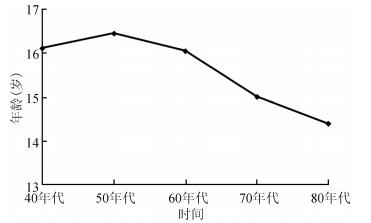
|
| 图 1 不同年代出生的成年女性月经初潮年龄变化趋势 |
4.月经初潮年龄与女性成年后近、远期肥胖的关系:多因素logistic回归分析显示,在不同的模型中分别纳入年龄、职业、文化程度、婚姻状况、家庭收入、吸烟、饮酒、运动、高血压、糖尿病、绝经情况等变量后,OR值差异均有统计学意义,随着初潮年龄的提前,女性近、远期肥胖的危险度均增加。模型1结果显示,初潮年龄过早的女性成年后罹患近期肥胖的风险是初潮年龄≥17岁的女性的2.45倍,OR值(95%CI)为2.45(1.74~3.45)。模型2结果显示,初潮年龄过早的女性成年后罹患远期肥胖的风险是初潮年龄≥17岁女性的1.99倍,OR值(95%CI)为1.99(1.69~2.34)。见表 3。
5.月经初潮年龄与绝经状态对远期肥胖的交互作用:将研究对象根据绝经状态分层,分层后月经初潮年龄过早仍然是远期肥胖的危险因素。在logistic多因素模型的基础上,通过logistic回归模型,纳入绝经状态与初潮年龄的乘积项,调整年龄、职业、文化程度、婚姻状况、家庭收入、吸烟、饮酒、运动、高血压、糖尿病等因素后,结果显示,月经初潮年龄与绝经状态对远期肥胖无相乘交互作用(P=0.324)。见表 4。
肥胖是21世纪全球面临的公共卫生挑战之一,相比于男性,女性成年后更容易出现肥胖问题[11]。本研究利用CKB项目苏州点成年女性的基线调查数据分析初潮年龄与女性成年后的近、远期肥胖的关系,结果显示,年代较晚出生的女性月经初潮年龄有不断提前的趋势并且初潮年龄过早是女性成年后近期肥胖与远期肥胖的高危因素。有报道称绝经状态与成年女性的远期肥胖有关[12],本研究在调整绝经状态等混杂因素后,女性初潮年龄仍然与女性成年后的远期肥胖有关,月经初潮年龄与绝经状态对远期肥胖无相乘交互作用。
Lakshman等[13]在一项15 807名欧洲地区女性营养状况的前瞻性研究中发现,初潮年龄过早者生命后期肥胖的风险性是初潮年龄较晚者的1.93倍。巴西一项在育龄期妇女中开展的病例对照研究结果显示,月经初潮年龄≤12岁是成年女性育龄期肥胖的潜在危险因素[14]。国内在江苏省泰州市开展的一项研究结果显示,与女性初潮年龄较晚组比较,月经初潮年龄过早者20岁时的BMI较高,差异有统计学意义[15],提示女性初潮年龄过早与女性成年后的近期肥胖有关。北京“宫内发育与成年人疾病”队列研究结果显示,控制绝经状态、年龄、运动、吸烟、饮酒等因素后,初潮年龄每提前1岁,女性青春晚期和中年期BMI分别增加0.58和0.35[16]。Charalampopoulos等[17]通过Meta分析发现,月经初潮年龄过早的女性全因死亡风险明显高于月经初潮年龄较晚的女性。此外,月经初潮年龄过早被认为是高血压、糖尿病、心血管疾病、MS的重要危险因素,也有研究显示,月经初潮年龄过早与糖尿病、MS的相关关系是通过肥胖来介导的。本研究结果显示初潮年龄越早,成年后患肥胖的风险越高,与以上国内外的研究结论一致[18-19]。
目前,初潮年龄对女性成年后近、远期肥胖的作用机制尚不完全明确。其中有一种可能是肥胖与青春期发动时相是相互影响的:很多研究表明儿童期肥胖是女性青春期提前发动的重要危险因素,初潮年龄过早是儿童期肥胖的一种表现形式,而40%的肥胖儿童将成为肥胖的青少年,80%的肥胖青少年可成为肥胖的成年人,青春期发育对体成分的改变和体脂蓄积有一定的影响[20-21]。另一种可能是初潮年龄较早的女性,其体内具有较高的雌激素水平和较低的性激素结合球蛋白水平,这种状态可能一直会延续到成年期,而内源性激素的改变容易导致肥胖。本研究结果提示月经初潮年龄是很好的独立于其他危险因素预测女性成年后近、远期肥胖的一项指标,但需要今后有更多的基础研究来探索月经初潮年龄与肥胖之间关联的生物学机制。
综上所述,初潮年龄过早的女性成年后近、远期肥胖风险增加。初潮年龄过早可以作为早期识别女性成年后肥胖的一项指标,所以尽早对这部分人群进行干预,改变生活方式,将有助于降低女性肥胖的发生。本研究是大样本研究,因此能够保证在调整很多混杂因素后结果仍稳定,但研究对象在回忆初潮年龄时会存在一定的回忆偏倚。因此,初潮年龄对女性肥胖的作用仍需用前瞻性队列研究进一步验证。
利益冲突 所有作者均声明不存在利益冲突
志谢 感谢CKB项目管理委员会、CKB国家项目办公室、CKB牛津协作中心和CKB苏州项目地区办公室的工作人员
| [1] |
季成叶, 胡佩瑾, 何忠虎. 中国儿童青少年生长长期趋势及其公共卫生意义[J]. 北京大学学报:医学版, 2007, 39(2): 126-131. Ji CY, Hu PJ, He ZH. Secular growth trends in the Chinese urban youth and its implications on public health[J]. J Peking Univ:Health Sci, 2007, 39(2): 126-131. DOI:10.3321/j.issn:1671-167X.2007.02.004 |
| [2] |
Liu G, Yang Y, Huang W, et al. Association of age at menarche with obesity and hypertension among southwestern Chinese women:a new finding[J]. Menopause, 2018, 25(5): 546-553. DOI:10.1097/GME.0000000000001027 |
| [3] |
Sun XT, Yang LL, Pan JX, et al. Age at menarche and the risk of gestational diabetes mellitus:a systematic review and meta-analysis[J]. Endocrine, 2018, 61(2): 204-209. DOI:10.1007/s12020-018-1581-9 |
| [4] |
Won JC, Hong JW, Noh JH, et al. Association between age at menarche and risk factors for cardiovascular diseases in Korean women:the 2010 to 2013 Korea national health and nutrition examination survey[J]. Medicine (Baltimore), 2016, 95(18): e3580. DOI:10.1097/MD.0000000000003580 |
| [5] |
Heys M, Schooling CM, Jiang CQ, et al. Age of menarche and the metabolic syndrome in China[J]. Epidemiology, 2007, 18(6): 740-746. DOI:10.1097/EDE.0b013e3181567faf |
| [6] |
Currie C, Ahluwalia N, Godeau E, et al. Is obesity at individual and national level associated with lower age at menarche? Evidence from 34 countries in the health behaviour in school-aged children study[J]. J Adolesc Health, 2012, 50(6): 621-626. DOI:10.1016/j.jadohealth.2011.10.254 |
| [7] |
李立明, 吕筠, 郭彧, 等. 中国慢性病前瞻性研究:研究方法和调查对象的基线特征[J]. 中华流行病学杂志, 2012, 33(3): 249-255. Li LM, Lyu J, Guo Y, et al. The China Kadoorie Biobank:related methodology and baseline characteristics of the participants[J]. Chin J Epidemiol, 2012, 33(3): 249-255. DOI:10.3760/cma.j.issn.0254-6450.2012.03.001 |
| [8] |
Chen ZM, Lee L, Chen JS, et al. Cohort profile:the Kadoorie study of chronic disease in China (KSCDC)[J]. Int J Epidemiol, 2005, 34(6): 1243-1249. DOI:10.1093/ije/dyi174 |
| [9] |
Chen ZM, Chen JS, Collins R, et al. China Kadoorie Biobank of 0.5 million people:survey methods, baseline characteristics and long-term follow-up[J]. Int J Epidemiol, 2011, 40(6): 1652-1666. DOI:10.1093/ije/dyr120 |
| [10] |
王浩, 胡如英, 钟节鸣, 等. 成年女性初潮年龄与糖尿病患病关系及交互作用的研究[J]. 中华流行病学杂志, 2016, 37(10): 1361-1365. Wang H, Hu RY, Zhong JM, et al. Association and interaction between age at menarche and risk of diabetes in adult women[J]. Chin J Epidemiol, 2016, 37(10): 1361-1365. DOI:10.3760/cma.j.issn.0254-6450.2016.10.009 |
| [11] |
王醴湘, 吕筠, 郭彧, 等. 中国慢性病前瞻性研究:10个项目地区成年人超重/肥胖现况分析[J]. 中华流行病学杂志, 2015, 36(11): 1190-1194. Wang LX, Lyu J, Guo Y, et al. Regional specific differences in prevalence of overweight/obesity in China:findings from China Kadoorie Biobank study in 10 areas in China[J]. Chin J Epidemiol, 2015, 36(11): 1190-1194. DOI:10.3760/cma.j.issn.0254-6450.2015.11.002 |
| [12] |
Hu FB, Grodstein F, Hennekens CH, et al. Age at natural menopause and risk of cardiovascular disease[J]. Arch Intern Med, 1999, 159(10): 1061-1066. DOI:10.1001/archinte.159.10.1061 |
| [13] |
Lakshman R, Forouhi NG, Sharp SJ, et al. Early age at menarche associated with cardiovascular disease and mortality[J]. J Clin Endocrinol Metab, 2009, 94(12): 4953-4960. DOI:10.1210/jc.2009-1789 |
| [14] |
Neves AG, Kasawara KT, Godoy-Miranda AC, et al. Early menarche and teenager pregnancy as risk factors for morbid obesity among reproductive-age women:a case-control study[J]. Clinics (Sao Paulo), 2017, 72(9): 547-553. DOI:10.6061/clinics/2017(09)05 |
| [15] |
吴娴, 王伟, 章月蟾, 等. 江苏省某地区自然绝经女性月经初潮年龄与MS的相关性分析[J]. 重庆医学, 2015, 44(12): 1669-1672. Wu X, Wang W, Zhang YC, et al. Analysis on correlation between menarche age and metabolic syndrome among natural menopausal women in an area of Jiangsu province[J]. Chongqing Med, 2015, 44(12): 1669-1672. DOI:10.3969/j.issn.1671-8348.2015.12.029 |
| [16] |
米杰, 陈芳芳, 王友发, 等. 早初潮对青春晚期及中年期肥胖的远期影响[J]. 中华流行病学杂志, 2007, 28(9): 833-837. Mi J, Chen FF, Wang YF, et al. Impact of early menarche on adiposity during late puberty and mid-life[J]. Chin J Epidemiol, 2007, 28(9): 833-837. DOI:10.3760/j.issn:0254-6450.2007.09.001 |
| [17] |
Charalampopoulos D, McLoughlin A, Elks CE, et al. Age at menarche and risks of all-cause and cardiovascular death:a systematic review and meta-analysis[J]. Am J Epidemiol, 2014, 180(1): 29-40. DOI:10.1093/aje/kwu113 |
| [18] |
He CY, Zhang CL, Hunter DJ, et al. Age at menarche and risk of type 2 diabetes:results from 2 large prospective cohort studies[J]. Am J Epidemiol, 2010, 171(3): 334-344. DOI:10.1093/aje/kwp372 |
| [19] |
Biro FM, Wien M. Childhood obesity and adult morbidities[J]. Am J Clin Nutr, 2010, 91(5): S1499-1505. DOI:10.3945/ajcn.2010.28701B |
| [20] |
Lee JM, Appugliese D, Kaciroti N, et al. Weight status in young girls and the onset of puberty[J]. Pediatrics, 2007, 119(3): e624-630. DOI:10.1542/peds.2006-2188 |
| [21] |
Silventoinen K, Haukka J, Dunkel L, et al. Genetics of pubertal timing and its associations with relative weight in childhood and adult height:the Swedish Young Male Twins Study[J]. Pediatrics, 2008, 121(4): e885-891. DOI:10.1542/peds.2007-1615 |
 2019, Vol. 40
2019, Vol. 40



